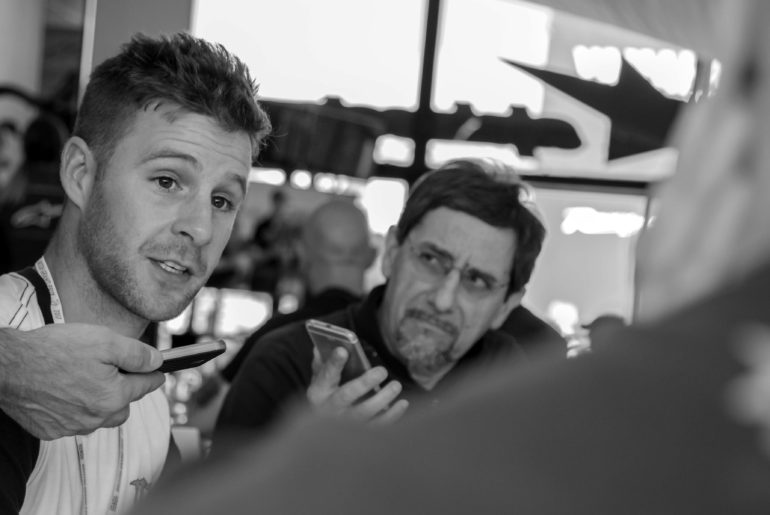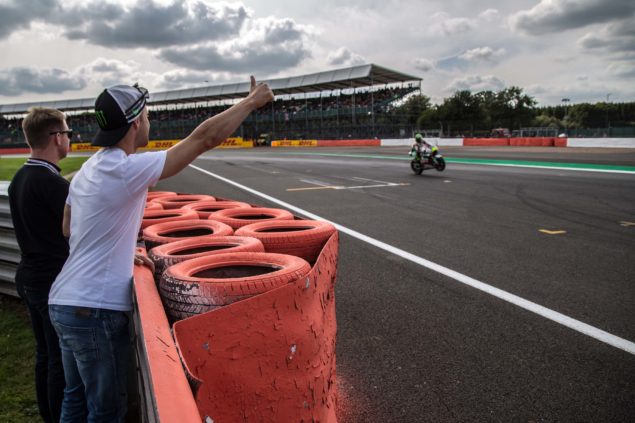At the British Grand Prix, two-time World Superbike champion Jonathan Rea sat down to talk about his standing in racing, and if he thinks he could cut it in MotoGP.
“It’s been a great weekend here at Silverstone, and I’ve been made to feel very welcome by everyone,” said Rea. “It was a nice feeling to have team managers, riders, journalists that I respect say ‘you should be here.’ It’s nice to hear that and it’s been great to see that the journalists here are really interested in WorldSBK.”
Sitting down with media from the United States, Europe, Australia, and Asia, the interest level in the double-WorldSBK champion was clear from the outset.
For 20 minutes Rea held court and offered his thoughts on his own career path, the strength of production-based racing and the challenges facing WorldSBK.
“I think that it’s easy to criticise from the outside, but at the races the attendance is improving,” said Rea. “Saturday is a lot busier now, and in Italy the profile of WorldSBK is getting bigger and bigger, because of the great job that Mediaset are doing.”
“I think that the biggest problem is the gap between Kawasaki and Ducati and the rest.”
“I’ve been on both sides of the grid, with a competitive bike, and also one where you’re trying to catch up. It’s an uncertain period because of the proposed rule changes and no one really knowing what way they’ll be.”
“I think that if the plan is to make the bikes closer to stock, than it would be better for the other manufacturers to be encouraged to spend more money on WorldSBK. I’ve no doubt that at the moment there’s two teams that are taking it seriously and others may not.”
“If you look back on the history of superbike racing it has always been about production bikes, but in the Foggy era it became more specialised. It was around then that Honda took it very seriously with the RC45 and that type of homologation special. It was production based, but they were special bikes.”
“It’s no different now, but it’s also important to know that Superbike is in an era where it is more standard than ever. Something needs to happen though, but whether it’s a superbike or a stock bike, I’ll be there to race it. The guys at the front are going really fast, but the gap to the rest is too big.”
The gap between a MotoGP bike and a WorldSBK machine was also a topic of conversation. Over the last two years, Rea has had the chance to view the Grand Prix missiles up close and personal during combined tests.
Having also watched from trackside at Silverstone, the Northern Irishman came away impressed, but also with a greater understanding of what makes his Kawasaki Ninja ZX-10RR special.
“At the tests in Jerez, I was able to compare where a MotoGP bike makes its laptime and where a superbike makes its time. That was really interesting for me, and the GP bikes carry more lean and roll into the corners a lot more than we do.”
“They don’t stop or accelerate particularly fast, but they can carry so much more momentum than us. You work with what works best for your tires, and from standing trackside and watching, it was interesting to see the lean angle that these guys carry.”
“The elbow down style doesn’t really work on a Superbike as much, because unless you have the leverage like a Baz or Redding, we can’t carry that angle. I was watching through Vale and Club during qualifying, and Marc’s lean angle through the long right was incredible.”
“We don’t have that grip with our tire, because the Pirelli makes its performance with grip on acceleration. We focus on stopping the bike to the apex, and then picking it up and accelerating.”
The opportunity to ride with the MotoGP riders did stir something inside of Rea, and over the summer he did explore opportunities in the Grand Prix paddock for 2018.
Ultimately, those opportunities came to nothing, but having raced for Repsol Honda in 2012, replacing Casey Stoner no less, he feels that he has been able to tick that off his list of career objectives.
“It was great to get that opportunity, and I’ll always be grateful to look at that set of leathers and know that I scored points in MotoGP. The guys racing in MotoGP are the best in the world, and for me to come here and compare myself to them I’d need the right equipment.”
“I wouldn’t come here just to be here. It’s a beautiful paddock, the bikes and technology are amazing, but I wouldn’t come here at all costs. I really enjoy the WorldSBK paddock and riding our bikes. I also love working with Kawasaki, and right now that’s where my opportunity is.”
“I think that I’ve probably missed the boat for MotoGP too because I’m probably too old now to come to MotoGP. Even when you look at Tech3 taking Zarco at 27, it had people thinking that maybe he was too old.”
“He’s turned into the revelation of the season though. For me looking at my CV at 30-years-old, there’s a lot going against me.”
Whatever the future holds for Rea, however, it’s most likely that he will continue wearing green.
“I have one more year with Kawasaki, and while I don’t want to race too long, I think that another two-year contract would be perfect. I’m riding better than I ever have. I think that experience counts for an awful lot in racing. The best situation for me would be to stay with Kawasaki and build a future with them.”
“For me though I’m not thinking too far ahead, because I’m lucky to have my contract sorted for next year. I’m sure though that in the middle of next year, my manager will be having a fun time in the paddock!”
“A lot of the MotoGP grid is open for contracts at the end of next year, and it’s the same in WorldSBK. All the official teams are open at the end of 2018, so it’ll be a fun silly season for everyone!”
That silly season is sure to see Rea linked with plenty of teams, and it’s certain that his management team will have their phones ringing off the hook. But Rea was keen to stress the importance of being on not only the right bike, but also in having the right people around him.
Over the last three years he has formed a near telepathic relationship with his crew chief, Pere Riba. The Spaniard, a former 500GP rider himself, has had a varied career as an engineer – but has always been able to build relationships.
That is arguably Riba’s greatest strength. Working with Joan Lascorz, he had a pure talent that would become a frontrunner before an unfortunate accident left him paralysed.
After Lascorz, it was Loris Baz that received the Riba treatment. The Frenchman was so raw that Riba focused solely on his mind and not the bike.
“With Joan it was easy to get the best from him,” said Riba. “He was so talented and hard working and great to work with. Loris was different! For the first two years together, we didn’t change the bike at all! I wanted Loris to relax and understand how to race.”
“He made a lot of progress, and by the end of our time, he was a very good superbike rider. Johnny though…he’s the best. There’s nothing more to say about him. His talent is superb and he’s very hard working. We’ve been able to have a lot of success together, and it has been great to achieve so much as a team.”
Indeed it is that “Team 65” element that has arguably been the most important part of Rea’s success in winning two WorldSBK titles and standing on the cusp of a third.
“Pere is great to work with, and wherever I end up in my career, I would want him there with me. He’s an ex-racer and he understands it. You can see though with Iannone going to Suzuki with his crew chief that it hasn’t worked for him.”
“Some people start to point fingers. It shows that bringing people with you has both positives and negatives. For me though it’s not just Pere, it’s the whole group of guys that I have working with me. They are incredible and I know that I’m really lucky to have them.”
Having learnt lessons through each stage of his career and each of the people he worked with, it was actually becoming a father that proved one of the biggest lessons for Rea.
“I think that my success came when I became a more balanced person. As I got older and my life stopped being just about being obsessed about the bike, it has meant that I’ve not been distracted by some things that in the past would upset me.”
“That’s been key for me and on track the amount of riding that I do helps. I ride a lot with different riders, and when I’ve been out with Marc Marquez on a motocross bike, he’s very impressive! You can learn a lot with those guys.”
“For me, my motocross background also has come in handy this year in Race 2, with the grid reshuffle. Starting from the third row means you need to react to what other people do. In a motocross race and you have to react to where the ruts develop around the track and make moves quickly.”
“I want to get to the front as quickly as I can. If you get stuck behind someone, you can lose a lot of time. My father always taught me in motocross that if you catch a guy you need to pass him. If you spend too long behind them you’ll stick to their speed.”
Over the last few years, and on the verge of a third straight WorldSBK crown, Rea certainly hasn’t been forced to stick to too many peoples’ speed.
Photos: © 2017 Steve English – All Rights Reserved
This World Superbike story is made possible by our A&R Pro members. Thank you for your support!





